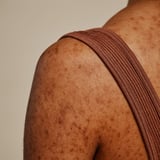How Hidradenitis Suppurativa Impacts Black Skin

Whether it's cystic acne or psoriasis, managing a skin condition comes with its own set of challenges. One condition in particular that often goes undiagnosed is hidradenitis suppurativa (HS), which also disproportionally impacts Black people. (In fact, a recent study indicates it's three times more common in Black people compared to other ethnic groups.)
Still, if you've never heard of HS – also referred to as acne inversa - you're not alone. The condition is known to be pretty difficult to diagnose, and can take time to understand. That said, when you know what to look for and when to get professional help, you can find treatment and relief from hidradenitis suppurativa.
To learn more about the condition, we spoke with a dermatologist. Keep reading to learn what exactly how hidradenitis suppurativa affects Black skin and what treatment options are available.
Experts Featured in This Article
Howard Sobel, MD, is a board-certified cosmetic dermatologist in New York City and the founder of Sobel Skin.
Michelle Henry, MD, is a board-certified dermatologist in New York City.
What Is Hidradenitis Suppurativa?
Hidradenitis suppurativa is a chronic inflammatory skin condition associated with the immune system. It occurs when keratin, sweat, and bacteria build up in hair follicles, leading to inflammation. "It affects about one percent of the population, and those who have it experience painful boils and abscesses may develop in areas where the skin rubs together such as under the armpits and in the groin area," dermatologist Howard Sobel, MD, tells PS. "It is more prevalent in women and adolescents and can run in families."
The condition looks like nodules underneath the skin's surface, and they can appear to be red, flesh-colored, purple, or darker, although that all depends on your skin tone, according to a study by Experimental Dermatology. For Black skin, HS "can present with many features including painful cystic lesions, pus-filled cysts, tracks under the skin, and open sores," board-certified dermatologist Michelle Henry, MD, says. "On Black skin, redness may not be as apparent, and lesions can appear as dark or purple hues instead of the typical red seen on lighter skin tones."
These lesions tend to grow and become inflamed before developing an abscess. These can often be mistaken or look like a pimple, boil, or ingrown hair. Once this abscess bursts open, it will drain from the skin, which leads to scarring as the wound heals.
Hidradenitis Suppurativa's Effects on Black Skin
HS can occur in people of any race or ethnicity; however, it occurs more frequently in Black people. More specifically, 2017 study by JAMA Dermatology found that for every 100,000 Black people, 296 have the condition. It also estimated that the biracial population has 218 cases per 100,000 people.
Hidradenitis suppurativa commonly occurs in specific areas of the body. "It affects where the coarse hair of Black skin grows in the armpits and groin area," Dr. Sobel says. "It begins with a boil, then another, and then a group of boils tunnel together and drain pus."
"The exact reasons why hidradenitis suppurativa is more common in Black individuals are not fully understood, but several genetic and environmental factors may contribute," Dr. Henry says. "Higher rates of HS-associated autoimmune disorders, such as psoriasis or lupus, and a genetic predisposition related to the immune system may also play a role.
Hidradenitis Suppurativa Treatments on Black Skin
When you begin seeing symptoms of HS, such as blackheads, painful pea-sized lumps, leaking bumps, and sores, it's important to see a doctor to begin treatment.
Often, antibiotics are used to treat hidradenitis suppurativa to reduce pus filled lumps and address the infection. Both of our experts say resorcinol peels are also a good option to treat this condition because of their antimicrobial and anti-inflammatory properties. They "open up clogged hair follicles and reduce inflammation," Dr. Sobel says. They can also "reduce pain and the duration of painful nodules in HS patients," Dr. Henry adds.
Additional treatment options include: acitretin, an oral retinoid; hormonal medications such as birth control pills, spironolactone, and finasteride; metformin, a diabetes drug that can reduce inflammation; and biologics, a class of drugs that use a living system (microorganism, plant cell, or animal cell) to works on the immune system to stop the pus and inflammation. Laser hair removal, cortisone injections, or excision of the lesions may also be helpful.
So, what happens if hidradenitis suppurativa goes untreated in black skin? When HS is misdiagnosed, often because it looks similar to other conditions especially if it is a milder case, Dr. Sobel says permanent scarring can occur. Seeing a dermatologist who specializes in this condition in Black skin can help you get a diagnosis quicker, leading to treating it before scarring begins.
Sydney Wingfield has been a freelance writer in the beauty and wellness space for six years. She has written for Women's Health, Marie Claire, Glamour, and other publications and loves to cover all things skin care, makeup, and hair.
Welcome to Billionaire Club Co LLC, your gateway to a brand-new social media experience! Sign up today and dive into over 10,000 fresh daily articles and videos curated just for your enjoyment. Enjoy the ad free experience, unlimited content interactions, and get that coveted blue check verification—all for just $1 a month!
Account Frozen
Your account is frozen. You can still view content but cannot interact with it.
Please go to your settings to update your account status.
Open Profile Settings